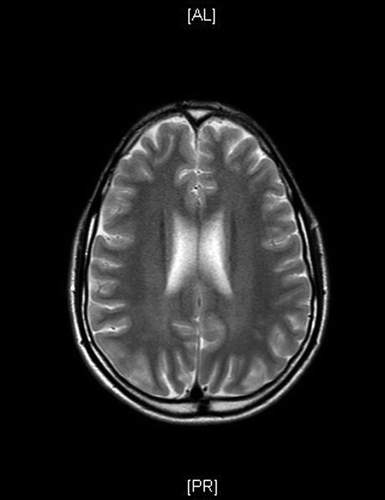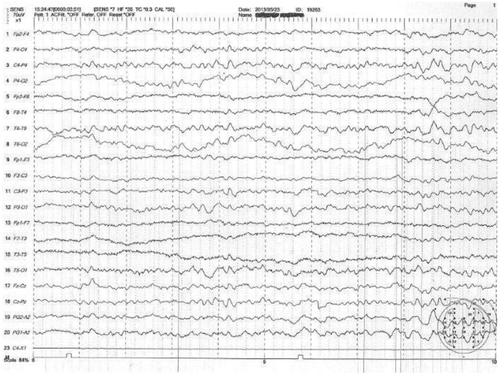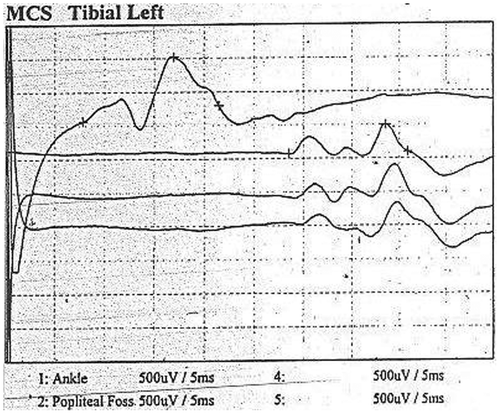Abstract
Inhalation of volatile agents, or solvent abuse, is a dangerous pastime practised by many young adolescents in various parts of the world. Benzine, a distillate of petroleum, is a cheap and readily available solvent that is often inhaled or “sniffed” to produce a short-lived feeling of euphoria or disorientation. The aim of this report is to describe four adolescents with severe polyneuropathies secondary to chronic benzine inhalation who were seen at the Steve Biko Academic Hospital in Pretoria’s Neurology Department.
Methods and patients: Four adolescent boys aged 15–18 years presented to the Department of Neurology from 2011 to 2013 with progressive weakness and muscle atrophy.
Results: On examination all patients showed signs of a severe motor and sensory neuropathy. Two were wheelchair bound at the time of presentation and an initial diagnosis of Guillain-Barré syndrome was considered. Cerebrospinal fluid analysis was normal and electromyography showed severe mixed motor and sensory mainly axonal polyneuropathies in all patients. All investigations for causes of neuropathies were normal, but all patients eventually admitted that they had been abusing benzine by inhaling it for a period of at least six months. The inhalation occurred as a group activity, involving many children.
Conclusion: Inhalant abuse appears to be a common practice amongst adolescents from Pretoria. It can lead to a catastrophic polyneuropathy, which should be considered in the differential diagnosis of a young patient presenting with a Guillain-Barré syndrome-type of clinical picture. Awareness amongst schools and drug programmes should be raised to prevent this tragic and highly disabling condition.
Introduction
Inhalation of volatile agents, or volatile substance misuse, is a dangerous pastime practised by many young adolescents in various parts of the world. Commonly used substances include deodorants and spray paint in aerosol cans, glue and thinners, but benzine is another cheap and readily available alternative. Benzine is a distillate of petroleum, consisting of a mixture of hydrocarbon components, and is often used as a solvent. Substances such as benzine are either “sniffed” directly from the container, “huffed” by inhaling the substance from a cloth soaked with the substance, or “bagged” by inhaling the substance from a plastic bag.Citation1 Sniffing or huffing produces a short-lived feeling of euphoria or disorientation, and is usually performed as a group activity. These practices are often regarded as relatively harmless, and are not classified as ‘illegal’ drug use.Citation2
Neuropathies due to n-hexane, one of the toxic components in benzine, have already been described more than 30 years ago after occupational exposure to solvents,Citation3 and several reports have shown that recreational glue, benzine and glue thinner sniffing can also lead to neurological complications.Citation4–7
A recent review on volatile substance misuse emphasised peripheral nervous system toxicity of several misused substances, including n-hexane. The n-hexane abuse can lead to a biphasic clinical picture with a severe peripheral neuropathy and “coasting” for some months after abstinence, with subsequently a slow and variable recovery.Citation8 In addition, central nervous system toxicity may occur, which includes encephalopathy, delirium, brain oedema and neuropsychiatric impairment.Citation8,9 There is also growing concern that permanent neurobiological changes may occur in young people with chronic misuse of volatile substances.Citation9 Both inhibition of glutaminergic neurotransmission at NMDA receptors and dopaminergic effects have been implicated in toluene abuse.Citation9,10
In South Africa, neuropathies due to benzine-sniffing have been described previously, especially in KwaZulu-Natal,Citation9,11 and electroencephalographic (EEG) abnormalities in patients indulging in glue sniffing have also been reported.Citation10,12 However, no recent reports of this condition have been found in the literature from South Africa.
The aim of this study is to create awareness of volatile-substance-misuse-induced severe neuropathy in South African adolescents by describing four young boys who presented in close succession to the Neurology Department of the University of Pretoria with this condition after sniffing benzine.
Methods
Approval for the publication of this retrospective report of four patients was granted by the Health Sciences Research Ethics Committee of the University of Pretoria.
The patients presented in close succession within an 18-month period to the Neurology Department of the University of Pretoria. They were examined clinically, electrophysiologically and radiologically, and routine blood investigations were performed.
Results
Three patients, aged between 15 and 18 years, presented at the end of 2011 to our unit with a three- to six-month history of progressive difficulty walking and one presented to Kalafong Hospital at the beginning of 2013 with a two- to three-week history of progressive weakness. Two of the patients were known to one another and attended the same school. At presentation, two were already wheelchair bound, and two were still ambulant but needed assistance with walking and activities of daily living. None had sensory complaints or visual symptoms, and none reported cramps, muscle pains or bladder and bowel dysfunction. Significant weight loss was a notable feature in all patients.
On examination, vitals were normal, as was the examination of the respiratory, cardiovascular and abdominal systems. All patients had severe muscle atrophy, especially distally, and two showed facial weakness in addition to the marked distal weakness and decreased deep tendon reflexes that were present in all. The clinical features of the patients are shown in Table . Work-up for causes of a neuropathy was unremarkable in all four, and lumbar punctures in all revealed normal protein, adenosine deaminase levels, glucose, cell counts and infective markers. HIV status was determined to exclude peripheral neuropathy due to HIV. The electromyography (EMG) showed a mixed motor and sensory polyneuropathy, mainly axonal with some evidence of demyelination in all four, with large neuropathic motor units and polyphasia and reduced recruitment on needle examination; visual evoked potentials (VEP) were normal in two patients in whom it was tested. A sural nerve biopsy of the first patient showed sub-optimal tissue sampling, but small fragments of nervous tissue without evidence of giant axonal swelling or demyelination were seen. Magnetic resonance imaging of patient 4 revealed mild frontal atrophy (Figure ), and an electroencephalogram (EEG) showed diffuse slowing (Figure ), indicating widespread cortical involvement. An example of the nerve conduction studies of patient 4 is shown in Figure . All of the patients eventually admitted that they had been abusing benzine for a period of at least six months by inhaling the fumes from a piece of cloth. Subsequently, the history was also given that a large number of pupils were involved in benzine sniffing. The benzine was obtained from a small local store and inhalation occurred as a group activity.
Table 1: Clinical findings
Figure 1: Magnetic resonance image of the brain of Patient 4

Figure 2: EEG of Patient 4

Figure 3: Nerve conduction study of the tibial nerve

In spite of intensive physio- and occupational therapy, the patients did not improve during their stay in the hospital. After discharge, one patient attended a follow-up visit at the clinic with little improvement after six weeks, while the others were unfortunately lost to follow-up.
Discussion
In this report we describe four adolescent boys who presented with a Guillain-Barré-syndrome-like clinical picture secondary to benzine sniffing. All had a severe mixed motor and sensory peripheral neuropathy that led to marked disability and little improvement over time.
Although inhalant abuse has been recognised worldwide as a hazard to adolescent health, little research is being done in the field,Citation13 and few specific South African epidemiological data could be obtained. One local study looked at risk behaviour in primary school learners in a disadvantaged community, showing that 3% of interviewed learners admitted to solvent sniffing.Citation2 It has also been shown that inhalant abuse often leads to other illicit drug usage, is often associated with social problems such as delinquency, depression and suicidal tendencies, and can result in serious systemic toxicity and death.Citation1
The substances used in inhalant abuse are common household products that are inexpensive and easy to obtain, even for children of a young age, as was also stated by our patients who were able to obtain the benzine from a small local shop at a very low cost (less than R10 per bottle). Used twice a day, such a bottle would last for one to two weeks. In addition, inhalant abuse has been correlated with peers doing it, such as on school grounds or at friends’ houses,Citation14 and in our patients one specifically reported that they would inhale benzine as a group whilst driving in the school bus to and from school every day. This patient was also aware of many other children in his and neighbouring schools who regularly inhaled benzine.
It has also been reported that inhalant abuse correlates with poverty, hunger, low education levels and boredom, amongst others,Citation15 but this was not further pursued in our patients. Patients generally start inhalant abuse very early in adolescence,Citation13 as was also the case in our patients. In the United States,Citation13 one study showed that 0.4% of adolescents between 12 and 17 years met the DSM -1 V criteria for inhalant abuse or dependence, but to our knowledge no data for South African adolescents are available. As previously mentioned, the study by Visser in 2003 found that 3% of learners abused solvents in a specific community.Citation2 Extrapolating from this and the reports of our patients, the numbers of adolescents involved in the east of Pretoria certainly is cause for concern.
The systemic complications of inhalant abuse include cardiac toxicity with arrhythmias and cardiomyopathy, respiratory problems such as dyspnoea and emphysema-like disorders, renal tubular acidosis, hepatitis and bone marrow suppression, and severe neurological sequelae, affecting both the central and the peripheral nervous system. Cortical atrophy, encephalopathy, brainstem dysfunction and damage to myelin have all been reported,Citation8,16 as have motor and sensory peripheral neuropathies. Our patients did not show signs of cardiac or other systemic involvement, but the severe weakness seen in two of our patients initially led to a clinical diagnosis of Guillain-Barré syndrome. It is thus important to keep inhalant abuse neuropathies in mind as a differential diagnosis in Guillain-Barré syndrome, especially in young patients who might not volunteer the history of substance abuse and who present with progressive weakness. Currently, there is no specific special investigation available that can diagnose this condition.
Inhalant abuse appears to be a common problem in adolescents from Pretoria. This does not appear to be sufficiently addressed in school awareness programmes targeting drugs, as it is often seen as a “kid’s drug” or not specifically dangerous when compared with illicit drug abuse. Importantly, the grave dangers of inhalant abuse, in particular benzine sniffing or huffing, should be brought under the attention of school programmes targeting the prevention of drug abuse. Ideally, the programmes should reach primary school children, since experimentation with inhalants appears to start very early in adolescence. Finally, as Lalloo et al.,Citation7,11 already proposed more than 30 years ago, the sale of benzine to children should be restricted.
References
- Anderson CE, Loomis GA. Recognition and prevention of inhalant abuse. Am Fam Phys. 2003;68(5):869–74.
- Visser M. Risk behaviour of primary school learners in a disadvantaged community- a situation analysis. SAJ Edu. 2003;23(1):58–64.
- Baker A, Tichy F. Effects of organic solvents and industrial poisonings on central nervous system. Proc Annu Res Ment Dis. 1953;32:475–505.
- Altenkirch H, Mager J, Stoltenburg G, et al. Toxic polyneuropathies after sniffing a glue thinner. J Neurol. 1977;214 (2):137–52. http://dx.doi.org/10.1007/BF02430351
- Hormaes JT, Filley CM, Rosenberg NL. Neurologic sequelae of chronic solvent vapor abuse. Neurology. 1986;36:698–702. http://dx.doi.org/10.1212/WNL.36.5.698
- Filley CM, Heaton RK, Rosenberg NL. White matter dementia in chronic toluene abuse. Neurology. 1990;40:532–4. http://dx.doi.org/10.1212/WNL.40.3_Part_1.532
- Dittmer DK, Jhamandas JH, Johnson ES. Glue-sniffing neuropathies. Can Fam Physic. 1993;39:1965–71.
- Ford JB, Sutter ME, Owen KP, et al. Volatile substance misuse: an updated review of toxicit and treatment. Clinic Rev Allerg Immunol. 2014;46(1):19–33. doi:10.1007/s1201-013-8371-1.
- Lubman DI, Yücel M, Lawrence AJ. Inhalant abuse among adolescents: neurobiological considerations. Br J Pharmacol. 2008;154(2): 216–26. doi: 10.1038/bjp.2008.76. Epub 2008 Mar 10. Available from: http://www.ncbi.nlm.nih.gov/pubmed/18332858
- Balster RI. Neural basis of inhalant abuse. Drug Alcohol Depend. 1998;51(1–2):207–14.
- Lalloo M, Cosnett JE, Moosa A. Benzine-sniffing neuropathy. S Afr Med J. 1981;59:522–4.
- Griesel RD, Jansesn P, Richter LM. Electroencephalographic disturbances due to chronic toxin abuse in young people, with special reference to glue sniffing. S Afr Med J. 1990;78:544–7.
- Wu L, Pilowsky DJ, Schlenger WE. Inhalant abuse and dependence among adolescents in the United States . J Am Acad Child Adolesc Psychiatry. 2004;43(10):1206–14. http://dx.doi.org/10.1097/01.chi.0000134491.42807.a3
- Johnson K, Holder H, Ogilvie K, et al. A community prevention to reduce youth from inhaling and ingesting harmful legal products. J Drug Educ. 2007;37:227–47. http://dx.doi.org/10.1016/j.evalprogplan.2011.08.001
- Lemstra M, Neudorf C, Nannapeneni U, et al. The role of economic and cultural status as risk indicators for alcohol and marijuana use among adolescents. Paediatr Child Health. 2009;14:225–30.
- Baydala L. Inhalant abuse. Paediatr Child Health 2010;15(7):443–8.
